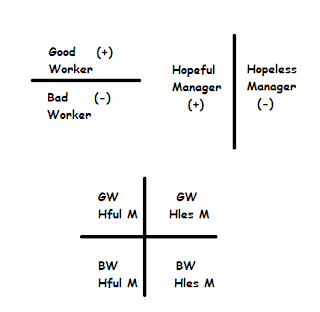What exactly are X and Y? Someone who loves maths would immediately jump to start solving values for x and y, looking for known and unknown variables. Pretty normal for a sixth grader, but not when you are sitting in Prof. Mandi's class and you're in a POM lecture at NITIE!
Theory X and Y refer to two STYLES of Managers who come under the X and Y type.
Theory X ('authoritarian management' style):
- The average person dislikes work and will avoid it he/she can.
- People must be forced with the threat of punishment to work towards organisational objectives.
- The average person prefers to avoid responsibility; is relatively unambitious, and wants security above all else.
Theory Y ('participative management' style):
- Effort in work is as natural as work and play.
- People will apply self-control and self-direction in the pursuit of organisational objectives, without external control or the threat of punishment.
- Commitment to objectives is a function of rewards associated with their achievement.
- People usually accept and often seek responsibility.
- The capacity to use a high degree of imagination, ingenuity and creativity in solving organisational problems is widely, not narrowly, distributed in the population.
- In industry the intellectual potential of the average person is only partly utilised.
The X and Y characteristics can be further explained as follows:
So we faced a similar contraption on the blackboard on Day Two of Prof. Mandi's class. In clockwise manner from the top left, the quarters were marked as 1 2 3 and 4 and the qualities of each of the 4 kinds of persons was put to discussion.
A grid containing the four characteristics can be formed with 1 being a Good Worker and a Hopeful Manager, 2 being Good Worker and Hopeless Manager, 3 being Bad Worker and Hopeful Manager and 4 being Bad Worker and Hopeless Manager. We all aspire to be number 1, as he represents all positive qualities. But all four forms of managers exist in today's corporate scenario. What really matters is how the manager extracts work from his employees and gets his assigned job complete in time.
My conclusions regarding the four kinds of managers are:
Type 1 - pleasant and amicable, manage people and resources well and optimally. Employees enjoy working under them. They always look upward for success and are always rewarded for their efforts and their colleagues' hardwork. Eg. Ratan Tata, Steve Jobs
Type 2 - hardworking but a poor manager. His employees are unmotivated and he is often let down by the lack of interest in working by his employees. His determination is not given due justice as he fails to manage his resources well. Eg. CEOs of struggling businnesess
Type 3 - good with people and resources, but doesn't know how to go about with the task defined to him. He often makes mistakes in management of time or resources but his employees are always motivated to work hard for success. Eg. Naveen Jindal
Type 4 - the worst kind of managers. These kind of managers always bring the corporate down and are often responsible for an organization's failure.
Coming up next, the importance of Craftsmanship as compared to Modern Management.
"Technology has evolved, and so should we" - Henry Ford


No comments:
Post a Comment